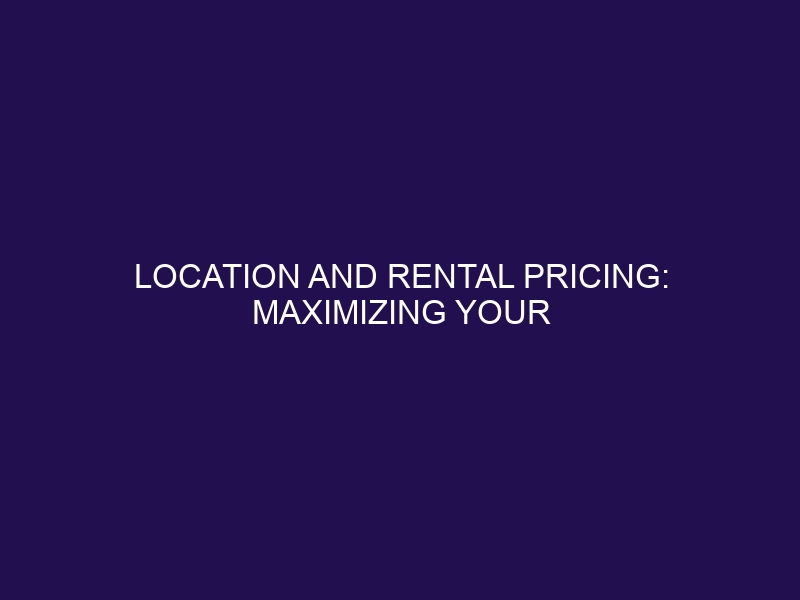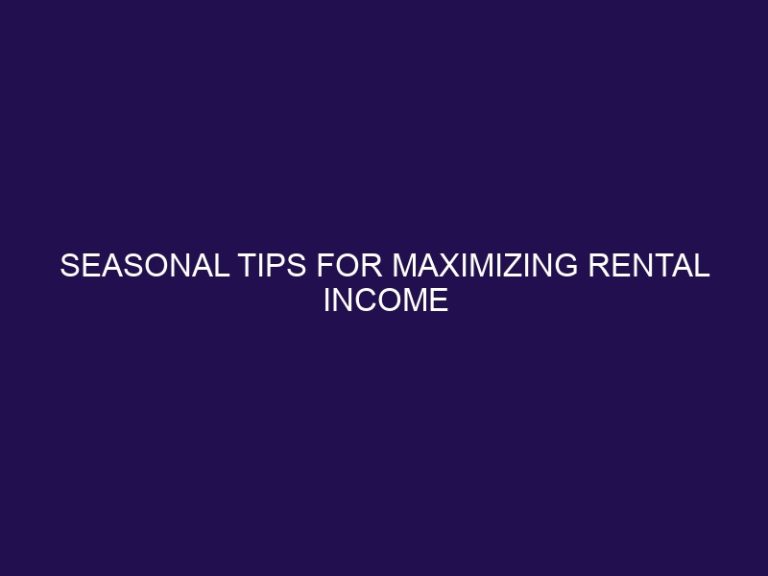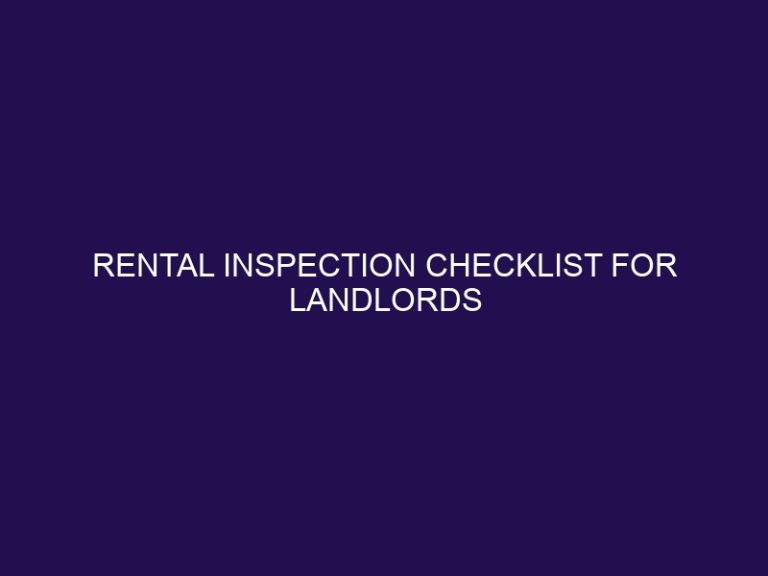Location and Rental Pricing: Maximizing Your Property’s Value
As a property owner, maximizing the value of your rental property is crucial for long-term success. One of the key factors that impact rental pricing is the location of the property. The location not only affects the initial rental price but also plays a significant role in the potential for long-term appreciation and income.
Numerous factors influence rental pricing in different locations. Understanding these factors can help property owners determine the optimal rental price for their property. One of the main factors is the demographics of the area. A neighborhood with a higher average income and educated population may command higher rental prices. Proximity to amenities and services such as schools, transportation, and shopping centers also plays a role in rental pricing.
The job market and economic growth of an area can also impact rental pricing. Cities with a growing job market and stable economic conditions tend to have higher rental prices. On the other hand, areas with high crime rates may have lower rental prices due to safety concerns.
To determine the optimal rental price for your property, it is important to research comparable properties in the area. Consider the amenities and features of your property and factor in the costs of maintenance and upkeep. This will help you find a balance between offering a competitive rental price and ensuring a profitable return on your investment.
To maximize your property’s value, it is important to regularly maintain and upgrade the property. This not only keeps tenants satisfied but also increases the property’s appeal and potential rental price. Attracting and retaining quality tenants is also crucial, as they are more likely to take care of the property and pay rent on time. Offering additional services and amenities such as parking, laundry facilities, or a gym can also increase the property’s value and potential rental price.
The location of a property also has a significant impact on long-term rental income and property value. Trends in rental prices and property values in different locations can vary greatly. An area with consistent rental price and property value growth may be a more desirable location for investment. Additionally, location can also affect the potential for appreciation over time.
In conclusion, finding the perfect balance between location and rental pricing is essential for maximizing your property’s value. By understanding the factors that influence rental pricing in different locations and consistently maintaining and upgrading the property, property owners can ensure a profitable return on their investment. Location plays a crucial role in this equation, and careful consideration should be given when choosing a property to invest in.
Understanding the Role of Location in Rental Pricing
Location plays a significant role in determining rental prices as it takes into account factors such as proximity to amenities, safety, and desirability of the neighborhood. To fully comprehend the impact of location on rental pricing, one must analyze the local demand, accessibility to public transportation, and nearby entertainment options, all of which ultimately contribute to the value of a property.
Factors that Affect Rental Pricing in Different Locations
When it comes to rental properties, location is a crucial factor in determining the value and pricing. However, there are various elements within a location that can greatly influence the rental pricing. In this section, we will discuss the key factors that impact rental pricing in different locations. From the demographics of the area to the job market to crime rates, we will explore how each of these aspects can affect the value and demand for rental properties.
1. Demographics of the Area
Understanding the demographics of the area is vital in determining optimal rental prices. Factors such as age, income level, and family size play a significant role in housing preferences and affordability. By analyzing these demographics, landlords can tailor property features and amenities to attract the appropriate tenants.
2. Proximity to Amenities and Services
- Conduct research on the proximity to essential amenities and services, such as grocery stores, schools, healthcare facilities, and public transportation.
- Evaluate the convenience and accessibility of these amenities for potential tenants.
- Analyze how the proximity to amenities can impact rental demand and property value.
3. Job Market and Economic Growth
When determining rental prices, it is essential to consider the job market and economic growth in the area. A thriving job market and strong economic growth can result in a higher demand for rental properties, giving landlords the ability to charge higher rental prices. On the other hand, areas with limited job opportunities and slow economic growth may require landlords to utilize more competitive pricing strategies to attract tenants. Staying updated on the local job market and economic trends is crucial in making informed decisions about rental pricing.
4. Crime Rates and Safety
When it comes to rental pricing, it is important to consider
- location and accessibility,
- property size and amenities,
- market trends and competition,
- crime rates and safety.
Properties located in high-crime areas may experience a decrease in value and rental income. It is wise to take safety precautions such as installing security systems and ensuring well-lit surroundings. Conduct thorough research on local crime statistics and safety ratings in order to make well-informed decisions.
How to Determine the Optimal Rental Price for Your Property
Determining the optimal rental price for your property is a key factor in maximizing its value. In this section, we will discuss the steps to take in order to find the sweet spot for rental pricing. First, we’ll cover the importance of researching comparable properties in the area and how it can inform your decision. Then, we’ll delve into how the amenities and features of your property can impact the rental price. Lastly, we’ll address the costs of maintenance and upkeep and how it should factor into your pricing strategy.
1. Research Comparable Properties in the Area
- Identify similar properties in the vicinity.
- Analyze their rental prices and features.
- Consider aspects like size, amenities, and condition.
- Adjust your property’s price based on the comparison.
During the early 2000s, real estate investors in Manhattan carefully examined comparable properties in the neighborhood in order to determine appropriate rental prices, ultimately contributing to the sustainable growth of the area.
2. Consider the Amenities and Features of Your Property
- Evaluate the unique amenities that make your property stand out, such as a pool or a scenic view.
- Consider the features that will attract potential tenants, such as modern appliances or ample storage space.
- Assess the condition of these amenities and features to ensure they are well-maintained and appealing to tenants.
As a property owner, I carefully assessed the amenities and features of my rental property. By investing in a new kitchen and enhancing the outdoor space, I was able to attract high-quality tenants and increase the value of my property.
3. Factor in the Costs of Maintenance and Upkeep
- Regular Maintenance: Schedule routine checks and repairs for plumbing, electrical, and structural components.
- Upkeep Costs: Budget for landscaping, painting, and general upkeep to maintain property appeal.
- Emergency Fund: Set aside funds for unexpected maintenance and repairs.
Did you know? When considering the costs of maintenance and upkeep, it’s important to factor in 1-3% of the property’s value for annual maintenance. This can help prevent costly issues and preserve the value of your property.
Strategies for Maximizing Your Property’s Value
As a property owner, it is important to continuously strive for ways to maximize the value of your investment. One key aspect of this is effectively managing and improving your property’s rental pricing. In this section, we will explore various strategies that can help boost your property’s value. These include regularly maintaining and upgrading your property, attracting and retaining quality tenants, and offering additional services and amenities to enhance the overall rental experience. Let’s dive into these approaches and see how they can benefit your property.
1. Regular Maintenance and Upgrades
- Regular Inspections: Schedule routine checks for property upkeep and early issue detection.
- System Upgrades: Invest in modernizing utilities and amenities for tenant satisfaction and efficiency.
- Appliance Maintenance: Ensure timely servicing and replacement of appliances for tenant convenience.
2. Attracting and Retaining Quality Tenants
- Maintain the property to attract and retain high-quality tenants.
- Offer timely maintenance services to ensure tenant satisfaction.
- Provide incentives for long-term leases to secure reliable and responsible tenants.
Pro-tip: Foster a positive landlord-tenant relationship by regularly communicating with tenants and addressing their needs.
3. Offering Additional Services and Amenities
- Conduct a survey to gain insight into tenant preferences and needs.
- Provide services such as laundry, parking, and pet-friendly amenities.
- Improve property value by offering additional features like a gym, community lounge, or outdoor space.
The Impact of Location on Long-term Rental Income and Property Value
When it comes to investing in rental properties, location is a crucial factor that can greatly impact both long-term rental income and property value. In this section, we will analyze trends in rental prices and property values in different locations, and how these factors can influence the potential for appreciation of your property. By understanding the relationship between location and rental pricing, you can make informed decisions to maximize the value of your investment property.
1. Trends in Rental Prices and Property Values in Different Locations
- Analyze historical rental price trends in various locations to identify patterns.
- Examine property value fluctuations in different areas over the years.
- Consult real estate reports and studies to understand shifts in rental prices and property values in different locations.
When exploring trends in rental prices and property values in different locations, it is beneficial to consult with local real estate experts and utilize online resources for comprehensive insights. Stay updated on market trends and projections to make informed decisions.
2. How Location Can Affect the Potential for Appreciation
- Location’s Influence: Proximity to schools, transportation, and future development can greatly impact the potential for property appreciation.
- Market Trends: It is important to research historical data on property appreciation rates in the area to understand the potential for growth.
- Urban Revitalization: Areas undergoing revitalization often experience significant property value growth, making them a potential hotspot for investment.
7 Tips for Setting the Right Rental Price
When it comes to renting out your property, setting the right rental price is crucial for maximizing its value. In this section, we will discuss 7 tips to help you determine the best rental price for your property. We will cover important factors such as your annual income, market value, and unique selling points that can impact your rental price. Additionally, we will delve into utilizing market data and highlighting desirable property features to set a competitive rental price.
Annual Income
When determining rental prices, it is important to consider tenants’ annual income in order to ensure that the prices are affordable and competitive. Conduct research on the average annual income in the area to get an idea of how much tenants are willing to pay. Adjust the rental rates accordingly to attract dependable, long-term tenants while also maximizing the earning potential of your property.
Market Value
Market value plays a crucial role in determining rental prices, as it reflects the demand for properties in a specific location. By understanding market trends and comparing rental rates, one can set competitive prices. A friend of mine adjusted their rental rate after carefully analyzing market value, which not only attracted quality tenants but also increased their long-term income.
Unique Selling Points
- Location advantages, such as scenic views or proximity to public transportation
- Special property features, like a rooftop garden or smart home technology
- Exceptional property management services and tenant care
Market Data
| City | Property Type | Median Rental Price |
| New York | Apartment | $3,000 |
| Los Angeles | House | $2,500 |
| Chicago | Condo | $1,800 |
Market Data
Property Features
Property features are a significant factor in determining rental prices. Attributes such as square footage, number of bedrooms, amenities, and overall condition have a direct impact on the value. For example, properties with modern kitchens, updated appliances, and energy-efficient fixtures can demand higher rents due to their desirable features.







